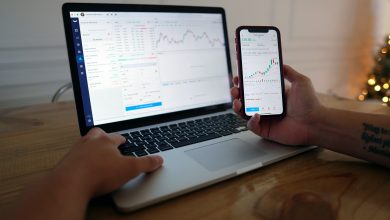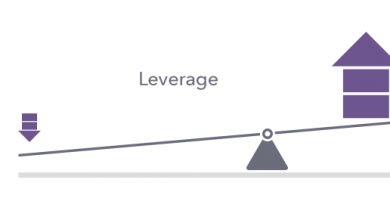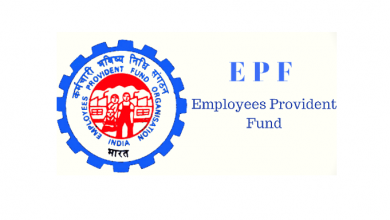TRADING THE BOVESPA INDEX IN BRAZIL
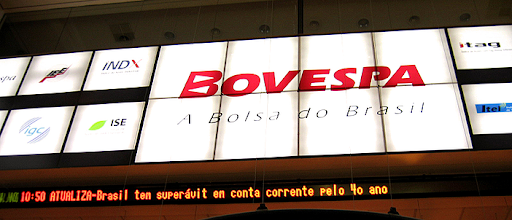
Brazil’s major stock market index is the Indice Bovespa (also known as the Ibovespa). Its purpose is to offer a comprehensive picture of the Brazilian economy at any given time, both in terms of its value and the sectors that make up its composition.
In 1968, Bovespa was established in Brazil as a hypothetical collection of equities that better reflect the Brazilian economy. Because Brazil is Latin America’s largest economy, the Bovespa is probably an excellent indicator of the region’s overall economic health.
The Bovespa and the Brazilian Commodities and Futures Exchange (BM&F) combined in 2008 to become BM&FBOVESPA. In 2017, BM&FBOVESPA acquired competitor business Cetip SA Mercados Organizados, resulting in the formation of Brasil Bolsa Balcao SA (B3).
The BM&F Bovespa was formed in 2000 when the stock exchanges of Sao Paulo and Rio de Janeiro, as well as nine other Brazilian cities, were merged to establish the BM&F Bovespa. Some analysts believe that, in addition to responding to economic variables, the Ibovespa’s path may also foretell the future of the Brazilian economy. When it became bullish while GDP shrank, this was apparent.
For a business to be included in the flagship Bovespa index, over 80% of its assets must be offered on the Brazilian stock exchange. The Bovespa, unlike so many other indexes, is an aggregation index, meaning it measures the current profitability of the investment that commenced with a value of approximately 0 on January 2, 1968.
In this article, you will find all you need to know about Trading Bovespa in Brazil.
Stock Exchange in Brazil
After the merging of the Sao Paulo Stock Market (Bovespa) and the Brazilian Mercantile and Futures Exchange, the BM&F Bovespa became the major Brazilian stock exchange (BM&F). The exchange, which was created in 1890, is officially known as Bolsa de Valores, Mercadorias & Futuros de Sao Paulo.
The largest stock market in Latin America, BM&F Bovespa, is located in the heart of Sao Paulo’s city center (the 8th largest in the world). BM&F Bovespa had a market value of $1.1 billion in December of 2011. 1.22 trillion dollars All Brazilian stock exchanges have been connected to BM&F Bovespa, including the BVRJ in Rio de Janeiro, which solely trades government bonds.
The Bovespa Index is the benchmark index of the Sao Paulo stock exchange (also called Ibovespa). Ibovespa is made up of the 50 most representative firms in the Brazilian market, both in terms of market capitalization and traded volume. BM&F Bovespa, on the other hand, presently trades 593 firms.
Bovespa: great history, huge growth.
Bovespa has a long history and continues to expand. When the Ibovespa was first introduced in 1968, it had a base value of 100. Brazil had periods of significant inflation in the 1980s and 1990s. To assist mitigate the impact on the Ibovespa’s worth, the entire value was split by 100 in 1983 and then by ten times between 1985 and 1997.
In 2008, Bovespa and the stock of commodities and futures contracts merged, giving birth to the present name of the Brazilian stock exchange: Bovespa. Bovespa BM&F. Brazil is well-known across the world for its significant economic impact. One of the reasons that the Brazilian stock market has the biggest market value in Latin America is that it brings together huge firms like Petrobras and Vale.
On March 18th, 2019, the Bovespa achieved an all-time closing high of 99,993.92 points. It had reached 100,000 points for the first time earlier in the day. The next day, the Bovespa reached an all-time intraday high of 100,439 points. Since its last division in 1997, the Ibovespa’s lowest value was 4,761 points in 1998.
In contrast to other capital markets across the world, BM&F Bovespa’s market value is approximately $726 billion, putting it in 13th position even amongst the world’s largest stock exchanges.
The following is a ranking of the world’s largest stock exchanges, based on the total value of all companies:
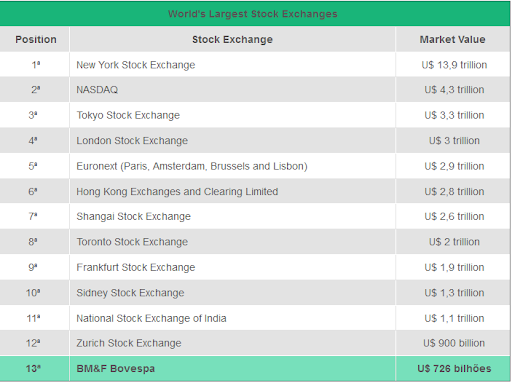
What is the significance of the Bovespa Index?
The Bovespa is a notable index since it covers Brazil, one of the world’s most important emerging economies. Because the Bovespa is a market-cap-weighted index, the largest companies have the most effect on its value.
The Ibovespa can be used as an underlying for ETFs, futures, options, and other products, in addition to reflecting the performance of other equities. The Ibovespa has what is known as “assumed to be fixed” restrictions in place to prevent significant decreases. Trading is halted for thirty minutes if the value of the current parameter falls 10% well below the previous day’s closing value.
If it dips below 15percent of the overall below the previous day’s closing value when trading resumes, the trade will be halted for another hour. If it dips below 20% below the previous day’s closing value when trading resumes, the exchange may opt to halt trading for a certain amount of time.
Bovespa Trading Hours and Calculation Intervals
The Ibovespa index is a primary market of companies traded on the B3 in Sao Paulo, Brazil. The days of operation are from Monday through Friday; Bovespa opening hours of 10:00 am to 5:55 pm closing hour (GMT- 03:00)Brasilia standard Time. During operating hours, the index is checked every thirty seconds.
The Bovespa’s Most Powerful Corporations
If we look at Ibovespa’s component companies by size, global Mining Corporation Vale S.A. is indeed the index’s greatest participant, accounting for 10% of the index’s weighting.
However, Petrobras, a part-publicly-owned petroleum multinational, publishes its favored and ordinary shares on the Ibovespa separately. These have a total index weight of little more than 13%.
The financial sector is by far the largest in the Ibovespa, accounting for 28.5 percent of the index’s weight. Banco Bradesco (which, like Petrobras, has dual listings for ordinary and company stock) and the Brazilian branch of the Spanish Banco Santander are the two with the most presence.
OGX, the oil firm whose underperformance in comparison to its size prompted the Ibovespa model modification in 2013, is no longer included in the index.
Bovespa Mutual funds
A diversified investment vehicle managed by a professional money manager that pools money from a variety of participants and invests it in a variety of assets. Ibovespa funds (also known as index funds) allow you to invest in all 60 stocks that make up the Ibovespa Index at once, reducing your risk and allowing you to profit if the Ibovespa increases. A mutual fund can be purchased through a broker or directly through the Ibovespa fund’s administrator.
Take into account that, unlike the Ibovespa ETF, mutual funds may only be purchased after the stock market’s trading day, not during regular stock market trading hours. Furthermore, mutual funds have greater costs than ETFs. If you’re thinking of investing in a mutual fund, it’s preferable to do so if you want to keep your money for a long time.
Performance Points for the Bovespa
Several elements influence the Ibovespa’s condition and, as a result, its performance. Domestic politics and interest rates are two of the most important issues.
To begin with, Selic is the benchmark Brazilian rate of return established by the Central Bank of Brazil. It’s from an all low of 6.5 percent right now, although the average for the preceding twenty years had been just under 15 percent and with highs of up to 45 percent. This is helping to improve market activity since consumers and companies now have more cash to spend or can borrow at a lower cost, resulting in increased industrial activity and higher stock prices.
To return to the first point, the Brazilian economy is inextricably linked to domestic politics. As we saw in 2016, the prospect of then-president Dilma Rousseff getting indicted for, among other things, fiscal mismanagement aided the development of the Ibovespa.
Jair Bolsonaro, the controversial Brazilian president, was elected in January 2019 on a platform pledging to cut government expenditure, decrease debt, and promote economic development. Markets rose to new highs as a result of this, but much hinges on the government’s ability to implement substantial pension reform.
At the same time, both inflation and unemployment have been growing. All of these elements have the potential to have an impact on the Ibovespa’s health. It should also be highlighted that, although reaching new highs in terms of points, the Ibovespa is still relatively low in value when measured in US Dollars when compared to previous highs.
Investing in the Bovespa Index
To invest in Bovespa, three main procedures must be followed:
• Decide on an investing strategy.
• Do your homework on Bovespa trading and pick a platform to invest in.
Select an investing strategy.
There are several alternatives to choose from. Consider variables such as the relative magnitude of transaction fees for each method, as well as the quality of customer care you want while investing to determine the ideal plan for you among all of those options. Here are a few of the most common methods to begin:
- ETFs
The ETF (exchange-traded fund) is a type of investment fund that may be exchanged like individual stocks on a stock market. ETFs provide flexibility and diversity by allowing you to trade them at any time during regular stock market hours. Treasuries, commodities, and valuable metals, as well as all of the equities featured in an index like the Ibovespa, are all included in Ibovespa ETFs. Because you’re investing in a diverse portfolio of 40 colored stocks while paying hefty fees, an ETF might be a wise decision. During a bad market, just stay away from stock index ETFs.
On the other hand, bear in mind that even when you buy a big group of companies, such as with the 40-stock Ibovespa Index, you’re getting both the best and worst performers in that group. Those who are pickier about their investments might prefer these other options.
- Individual stocks
You can make separate transactions to acquire shares of the 40 individual stocks that the index monitors if you want to focus on the top-performing firms in the Ibovespa Index rather than the whole index. This allows you to analyze each stock as you go, whittling down your holdings until you’re just holding the top-performing Ibovespa Index companies.
Buying 40 different equities has the disadvantage of necessitating 40 separate trades (plus even more trades when you sell the ones you decide not to keep holding). Large transaction costs and a lot of time spent trading are the results of this strategy. Beginner investors with limited resources and time may be put off.
Do your homework on Bovespa trading and pick a platform to invest in.
- Do your research.
To succeed at investing, you’ll need time, effort, and patience. If you’re thinking about investing in the Ibovespa Index, think about all of the advantages and disadvantages. Create a sensible investing strategy to increase your chances of success. Even when the stock market gets turbulent and unexpected, the more prepared you are, the more equipped you will be to retain your calm.
- Make a financial plan.
Your budget should take into account your risk tolerance as well as the amount of money you can afford to lose. Allowing your losses to accumulate might damage your confidence and make it difficult to acquire cash for future deals.
- Choose the appropriate platform.
One investor may pick a platform solely based on the number of its transaction costs, while another may place a greater emphasis on the quantity and quality of financial advice available. As a result, before you begin your search, you should have a clear understanding of your investment objectives.
To make that happen, you must select where you want to invest your money. Here are a few of the top choices accessible to you:
- Trading platforms and brokers
Brokers provide a variety of online tools and are frequently the most efficient method to invest in the Ibovespa Index. However, because internet brokers seldom provide in-depth investing advice, there are choices to consider if you want a more customized service to help you make decisions
- Advisors in the financial field.
Financial advisers provide the most investment advice to investors at the most expensive price. They’ll go through your financial objectives with you in great detail and work with you to achieve them. It’s no wonder that financial advisers charge a premium for their services given their level of care. Given the high level of customer care they provide, this can sometimes be worth the price, but Ibovespa Index investment isn’t too difficult, so a financial adviser is a cost you can go without.
- Gradually increase your investment.
You can begin by investing a little amount of money if you are a novice investor. You may always raise your capital and invest more as you acquire expertise and make good selections. This steady approach will help you avoid large losses while also maximizing your earnings over time.
Consider the long term. Long-term success may be achieved by purchasing and holding the Ibovespa Index and aiming for higher returns. If you’re going to hold for a long time, do your homework and make sure the Brazilian economy is on the upswing. Indicators such as the Ibovespa will fall as a result of bear markets.
- Advisors who are robots.
Robots and Robo advisers are trading systems that use algorithms to make trades automatically. Although the robot advisor process is designed to be automated, some robot advisors will allow you to speak with a real person about your investing strategy to create a good plan. When you combine such guidance with cheap trading fees, you have a compelling alternative for many investors. However, robot advisers still provide a more hands-off approach than a human financial counselor.
- Banks.
Your bank allows you to keep all of your financial instruments in one location, including your checking and savings accounts, as well as your investments. The issue is that banks frequently demand hefty fees while failing to provide the same quality of service as top financial consultants. As a result, banks frequently fail to provide the ideal balance of service and pricing. A bank is unlikely to be your greatest option unless convenience is your main concern.
Bovespa Margin trading
This is when you trade on a little amount of money. Some brokerages may lend you money to help you finance your trading, with the loan secured by your account’s securities. This is referred to as margin trading. Margin trading may appear to be a tempting prospect, but it is a high-risk technique suited for experienced, professional traders. The reason for this is because if the assets in your account fall below a particular value, the broker might issue a “margin call,” requiring you to either add additional cash to your account or sell assets. Alternatively, the broker might close your account without your permission and leave you with nothing.
Bovespa Trading Platforms
A trading platform is an electronic piece of software offered by a broker that allows you to trade on financial markets. A solid trading platform will provide you with all of the information you want on market performance, including real-time data, historical data, the capacity to plot averages, and, most crucially, the ability to purchase and sell shares (also known as opening and closing a position).
Trading platforms are usually expensive, however, they might be given away for free if you complete a specific number of trades each month with the broker who provides them.
It’s important to note that different trading platforms are designed to meet the demands of different traders. There are ‘commercial’ platforms, for example, that are targeted to day-traders and provide greater support in terms of decision-making tools. Platforms for professional traders with specialized needs and trading techniques, on the other hand, are known as ‘prop’ platforms.
If you want to trade on the Ibovespa, it’s critical that you not only pick the proper broker, but also one that can supply you with a suitable trading platform. If you simply want to buy and sell stocks, it’s futile to invest in a cutting-edge prop platform designed for options trading. Simultaneously, a platform that is inexpensive but has a lot of bugs or delays, can cost you money in the long run since you might miss a great opportunity to purchase or sell.
Selecting the Most Valuable Bovespa Stock Volume
Volume is a helpful signal when looking for the correct stock to initiate a trade on or the right moment to close an existing one. Volume refers to the number of shares that have been traded in a market. Only one transaction is counted (so if C sells 200 shares to D, the volume is 200, not 300 because C sold to D and D bought from C). The bigger the volume driving a price change, the more dependable that price change is as a trend indicator.
Beta and Volatility
Volatility is a key indicator of a stock’s price stability. It is computed by predicting a stock’s price range using historical data. The higher the volatility of a stock, the more likely it is to change in price by a wider margin than equities with low volatility. Day traders seeking to profit from short-term price changes will naturally gravitate toward the most volatile equities.
Beta is a metric for comparing relative volatility. Beta is a metric that relates the volatility of a single stock to the overall volatility of an index. The most neutral point of Beta is 100 percent, and every 0.1 of beta equates to 10%.
This is when a stock’s unsystematic risk is most closely associated with the market’s systematic risk. Because its price is steadier or changes more slowly over time, a stock with a beta of less than 1.0 has lower volatility. Stocks with a beta greater than 1.0 have more volatility than the market average because their prices move faster.
Unsystematic risk exists in stocks since there are variables that might impact the underlying firm or industry, causing prices to fall. This risk can be mitigated by diversifying one’s portfolio of assets. In indices, systematic risk arises because some variables can influence a whole market – such as the global financial crisis of 2008 – that no amount of diversification can prevent.
Trading on the Bovespa is safe.
When we talk about securities in trading, we’re referring to all of the numerous tradable items on the market, such as stocks, options, ETFs, futures, mutual funds, bonds, and so on. Since with picking a broker, it’s critical to make the best decision for you, as each security has its own set of advantages and disadvantages. We have an article here that explains some of the different types of trading if you want to learn more.
An exchange-traded fund (ETF) is a collection of assets that track a certain index, in this case, the Ibovespa. ETFs can hold a variety of assets, but for simplicity, we’ll assume we’ve purchased an ETF that holds shares in each Ibovespa component stock. Over a trading day, the value of our ETF will rise or fall following the value of the Ibovespa.
One of the biggest advantages of ETFs is that they usually have minimal commissions and are less expensive than buying all of the member equities individually. The demand for them is a source of concern since it artificially inflates the value of indexes, causing price bubbles to grow and collapse.
Is it wise to invest in Ibovespa?
It depends on your specific investment objectives. Brazil’s economy has developed rapidly in recent years, and it remains a big and strong global participant as one of the so-called BRIC (Brazil, Russia, India, and China) countries. The Ibovespa Index provides you access to 60 firms from a range of industries, allowing you to profit from portfolio diversification and protect yourself against stock market swings.
Final Thought on Trading the Bovespa index in Brazil.
The Ibovespa is an interesting index to follow and analyze, not just because of its origin and technique, but also because it is the benchmark index for Latin America’s largest economy. Due to the political events of recent years, a word of caution should be raised as a possible investment index. The market has been trending upward, but only experienced traders or those who follow Brazilian politics. Trading and investing should be carefully considered.
While Brazil is a huge economy, it also has a high level of political instability, as this has been demonstrated over the years; if you are inexperienced with the country’s political environment or are unwilling to become deeply involved in it, the Ibovespa is not a good investment.
Watching business news networks or programs on TV, such as Sky News Business Channel, BBC Business Live, and Bloomberg Television might help you be informed as well as have an understanding of the Brazilian economy. Furthermore, a thorough reading of The Financial Times would also enhance your knowledge and set you on the right course for successful Bovespa index trading.

